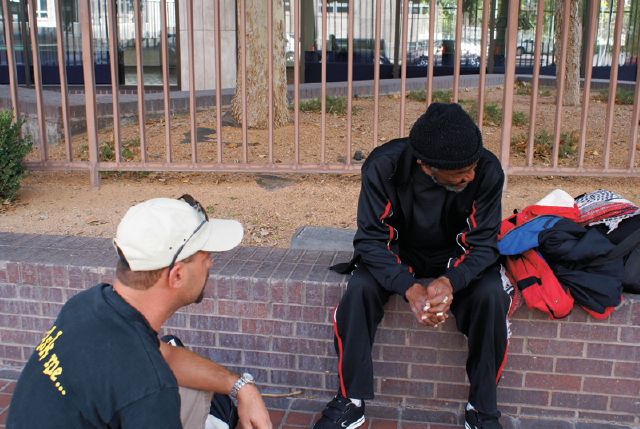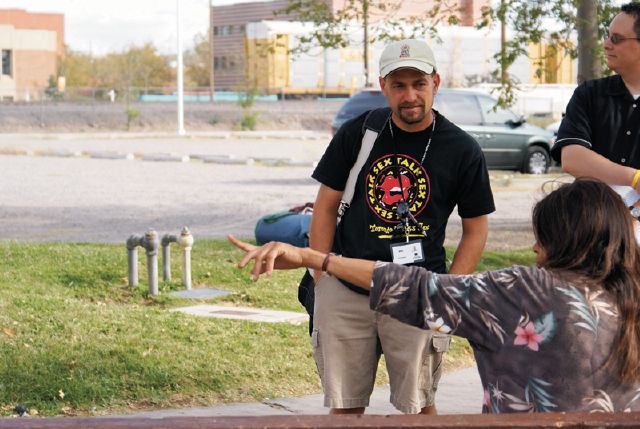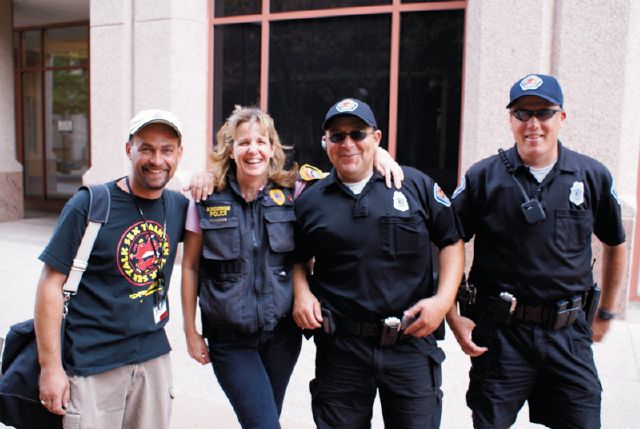NOTE: The names of the homeless people in this story have all been changed. They meet in an office downstairs in the Galleria, usually on Thursdays. It’s a medium-sized room that doesn’t look like it’s often occupied—the only human touches are a collection of movie posters adorning the walls. Most of this work doesn’t take place in an office; it happens on the streets of Downtown, near the public library, on the "grassy knoll" near the freeway and Martin Luther King Jr., in Civic Plaza, on the Fourth Street Mall, in Robinson Park.Like any other meeting, it begins with copies of an agenda handed around to the three officers and four providers present. On the agenda is a list of names, homeless people the team has been trying to help and keep track of for months. They start at the top: Sam was in awful shape yesterday. He was badly beaten. He’s due for a shower.Redman has no family we can track, though he wants to find his way back to his mother.Cathy’s gone, but she’ll be back. She was last seen being lifted out of a car by a couple and put in cab heading south. Tim was found dead in Robinson Park.Richard doesn’t want help, but he’s compliant. Stan got in a terrible fight and was kicked out of the motel he was staying in. He’s either hiding out with a friend somewhere, or he’s dead.Was Sarah raped?Margaret stopped bathing nude in the Civic Plaza fountain and is showing up at the monthly women’s meetings. It’s a brutal list, and it goes on. Health Care for the Homeless estimates there are at least 3,000 people without homes in Albuquerque on any given night, says Dawne Bell, development coordinator for the agency. Since the population is always transitioning, there are an estimated 10,000 homeless people in town over the course of a given year. The homeless service providers and the officers share their stories of who saw who last and where, how they looked, what they were doing. Jodi Jepson, who works for APD’s Crisis Outreach and Support Team, is "forever the optimist," she says. She wants to help Gary, who’s been around for years, who speaks to himself, and who doesn’t want help. She wants to keep trying with Tracy. Though everything’s been set up for Tracy to enroll in social programs, she won’t leave the street, the drugs, the abusive situations she gets herself into with men. The team members give each other a hard time. "His clothes were so gross, it made me puke last time I had to clean him," laughs Wil Wroda of Healthcare for the Homeless. "Wil, you work with the homeless," Detective Elizabeth Thomson teases. It’s camaraderie, and not that long ago, it was noticeably absent in the relationship between providers and police. "There was downright bad tension between the helping professions," Thomson says. Social workers, case managers and doctors typically think of police not as their partners but as their adversaries. "What we would hear from them is, ‘You’re harassing homeless people. You’re brutalizing them. You’re stigmatizing them.’” Reaching Out Thomson’s been an officer for eight years. She became interested in specialized work with the homeless about a year ago. An outreach program in Phoenix that united providers and officers provided an example of a way to bridge that all-too-common gap between officers and providers. On March 10, the Downtown Strategic Outreach team, a collaborative effort of APD and a variety of social agencies, went out for the first time. Members vary slightly from week to week depending on who is available, though a core group hits the street on Thursday afternoons, Friday mornings and every other Sunday. They tote a few heavy bags and joke about who seems to escape carrying the load every time. Wroda’s bag is full of toiletries, Slim Jims, water, and yellow resource cards listing the available meals, shelters and programs in the city. "I heard about these yellow cards," says one man from Denver who hasn’t eaten in three days. The cards are updated every six months, because you can never tell which agencies are going to be around, Wroda says. Kate Schneier of New Mexico AIDS Services carries hygiene kits, safer sex kits with condoms, granola bars and more water. They call it "walking outreach," and it all happens on foot. Individual team members have established rapport with many of the people who hang around the Downtown area. They approach people in small groups, so as not to overwhelm them. Wroda walks up to a man sitting at a table in Civic Plaza. He shakes his hand—he shakes everyone’s hand—and takes a seat. He greets Jimmy, a sweet guy, a POW during Vietnam and quite lucid. He’s allowed to hang out on the Plaza because he doesn’t panhandle and he never causes trouble. He’s been homeless for about 20 years, according to Wroda. Sometime in the near future, Jimmy will get a check for about $200,000. It’s years’ worth of back pay from the Department of Veterans Affairs. "They told him he couldn’t take care of his money on his own and that he had to have a payee," Wroda says. "He basically said, ‘Fine, I just won’t take the money.’" He voluntarily terminated his benefits, as best Wroda can tell. Wroda and Officer Jerome Armijo talked him into accepting the large chunk of back pay and the future monthly payments of about $2,400. They’re trying to talk him into buying a house with the money, but Jimmy hates being indoors. Wroda asks Jimmy if a little house with a big yard that he could live in would be acceptable. Jimmy says he’ll think about it. For Wroda, that’s a victory. The team moves on, saying hello to some who appeared on the morning’s agenda list and some who didn’t. Redman was on the list. He’s looking for a way back to his mother. He’s a young guy, soft-spoken. He gives the police a big smile when he sees them. Smiles from the regulars Downtown are a new development, too."When I first started, it was different," says Officer Terry Dye. "We did not come out with snacks and drinks. We’d move ’em on, get ’em out of here." And the homeless used to be afraid of the Downtown officers. "People talk to us now. They’re not afraid. If something happens, they can tell us." Redman tells the officers his mom lives in California, and they’ve been talking on the phone. Jepson promises to track her down. Wroda thinks he might be able to get Healthcare for the Homeless to pay for a bus ticket. It’s a good day, says Wroda, lighting a smoke. They’ve had productive conversations with Jimmy and Redman, conversations that could lead the men off the streets. Thomson checks her brand-new pedometer. "We’ve only walked two-tenths of a mile and been gone 16 minutes. We did that in 16 minutes." The team works its way through the Fourth Street Mall and then along Copper toward the Main Library. An older gentleman with a long white beard and a cap pretends to shoot officer Armijo with his cane. They laugh. "At first, he was quiet, standoffish," Armijo says. The man is one of those rare individuals who just prefers to be homeless, Armijo marvels. He just lives outside. Winter doesn’t bother him. "It’s a decision he’s made." He doesn’t require any services. The officer warns him that there’s going to be a sweep of the camps along the railroad tracks. "So, if his camp is there … ” his voice trails off.It’s a tricky line to walk for the officers and the service providers. One woman Jepson speaks to gets a little rowdy. She smells of urine and wheels herself around in a wheelchair she might not even need—a panhandling trick. Schneier walks away. "I walk away from the police when they’re doing the police aspect of it, because I don’t want to breach trust with clients."They regroup and head to the park. As the officers approach Robinson Park, some people get up and flee. "With all of us working together," says officer Armijo, "we know who’s who—who’s down on their luck and who’s here dealing dope." Dealers often use the homeless as camouflage and try to blend in, he adds. Though the team is only a few feet away, one man won’t make eye contact and stares determinedly ahead. He’s drinking a Slurpee and wearing a heavy winter overcoat despite the heat of the bright September day."What are you doing out here?" Armijo asks."Sick," says the man."Sick of what?" "Heroin. I’m trying to get clean." The officers and Nils Rosenbaum, a doctor and fourth-year psychiatry resident at UNMH, discuss with the man the possibility of Buprenorphine, a drug that helps people kick the habit. While Rosenbaum writes some information down for the man, the officers gesture to Wroda before walking to a bench a ways off and sitting down. This is so Wroda can give the man clean needles. "They walk away, just like we walk away when it becomes law enforcement," Wroda says.That’s one day: Jimmy might buy a house. Redman might take the bus to see his mom. The guy suffering withdrawals in the park might fight his way off heroin. And it’s only 1:30 in the afternoon. Mama Donna Two weeks later, Donna Rowe is getting ready to lay down and shut her eyes on a lit concrete structure in the middle of Civic Plaza. It’s 9 p.m. on Wednesday, Oct. 4. It’s cold. The strong wind blows her lank blond hair into her face. This was supposed to be a protest, a tent city erected outside the City Council chambers that would raise awareness and maybe funds for Albuquerque’s homeless youth. Instead, it’s Rowe, a guy maybe 20 years old in a sleeping bag and a girl sitting with her arms crossed, listening carefully to every word Rowe says. Another young woman paces, calling people on her cell phone. It made the news that morning. "Homeless youth to camp on Civic Plaza," said KOBTV Channel 4. There are no tents. There are four people. Security has informed the group, sitting among empty soda cans and half-eaten bags of chips, that Civic Plaza is a park. Parks close at 10 p.m. Still, Rowe’s hoping. She’s hoping 20 or 30 more people might show up, making it safe for her to refuse to move from the Plaza. If not, there’s talk of taking it to the sidewalk or the steps of City Hall. Rowe, called "Mama Donna" by the young homeless people she helps, spoke at the Council meeting, along with those she calls "her kids." Youth In Transition (YIT) is out of money, she says. A controversial and unconventional organization, Rowe started YIT out of the back of a van in 1995. It later became a drop-in center (sometimes again operating out of Rowe’s vehicle) that migrated over the years as funding ebbed and flowed. A fire burned down YIT’s center in 2002. Rowe was accused of arson. She was found not guilty on all charges.Rowe’s mission is to provide young homeless people with a place that will never turn them away. There are two other shelters for teens in Albuquerque: Amistad and New Day. Neither take people over 17 or under 12. Combined, they have 28 beds available. "They only take the cream of the crop," Rowe says. "There are probably close to 1,000 homeless young people between the ages of 14 and 24 tonight in the little nooks and crannies all over the city—on rooftops, by the heater vents on the UNM campus, in parks stashed in bushes because they can’t be there after 10 … and nothing’s happening." The young people with mental illnesses, the ones strung out on drugs or who curse or whose behavior is too erratic for the systems in place—those are Rowe’s kids. They’re kids like her—like she was. Rowe was homeless in Albuquerque on and off from the time she was 15 until she was 23. That was 35 years ago, and things are much more violent and drug-addled today than they were then, she says. She’s conflicted about the idea of soliciting city money. "The city owes it to these kids," she says. But what strings would be attached? She’s not going to Breathalize people, she says. "This is not a quick-fix population." They don’t fit well in the adult services. There’s not enough beds for the adults, either, she says. It’s a chasm, and many fall through. The minutes tick by. It’s 9:30 p.m. now. The wind picks up. Eviction from Civic Plaza approaches. Rowe’s disappointed, she says, looking around at protesters who aren’t there. "Ask them where their balls are," she raises her voice. "What about all the human rights activists in this city?" she yells at the empty Plaza. "Where the f— are you?" Rowe was arrested shortly after 10 p.m. that night on charges of refusing to obey an officer. She was released on a $100 bond and is facing a mandatory court date on Oct. 18. According to the criminal complaint, "Rowe stated she wanted to be arrested to prove a point that homeless people need a place to sleep.” Asleep in the Shade The next afternoon, the team is on foot again. Near the three-way intersection of Copper, Martin Luther King Jr. and Broadway, a woman naps in the grass under a tree. A man is walking quickly around the small grassy median, picking things up off the ground and shouting, "Why won’t they sit down?" An emaciated woman watches him from a bench. A subtle sense of alarm is present in the team. Thomson positions herself close to where the man is moving jerkily, keeping her distance as officers Armijo and Dye have not yet met up with the team. Wroda approaches the napping woman to ask if she wants water—maybe to make sure she’s only sleeping. Thomson calls to Wroda, "Wil, you’re going to do outreach with Mr. ‘I’m Having a Psychotic Break’ over there?"The thin woman on the bench speaks. "He does that every day," she says. "He cleans everything up on Central and Copper. Then it gets all dirty again right away." It becomes clear that the man is not just picking things up and putting them down again, as it first appeared. Instead, he’s collecting garbage and throwing it away. Armijo and Dye arrive. They’ve already put in 21 hours of overtime this week. But here they are. "What’s going on here?" Armijo nods to where the woman continues to sleep in spite of the commotion. "Just a nap," Thomson says. Soon other homeless people are making their way to the median. Wil hands out water and snacks. It’s like a reunion. Thomson compliments one woman on her hair and makeup. Everyone knows everyone else’s name. People tell jokes. Discourse is lively. As the team walks away, Thomson’s thinking about the women the group’s seen today, which are many, though proportionately there are more homeless men in the city. Unless the old jail that’s been coverted to a shelter on the Westside is open for the winter, there are few places in town for women to go, she says. "If you’re part of a couple, you’re pretty much screwed." If a woman shows up at the men-only shelters, she will be turned away. "Basically, they put them on the street." There are gaps in Albuquerque’s services, specifically for women and teens, but the Downtown Strategic Outreach team’s success is the story these days. Reports of panhandling are slackening Downtown. There is talk of setting up something like it in the Nob Hill area. "Nob Hill was second on the list of where there’s complaints," Thomson says, "and there’s also a feeling or response from the community—like business owners, citizens—that they’ll collaborate with us."Wroda’s looking for Jimmy, the quiet gentleman who was supposed to receive $200,000 in back pay from the VA. He hasn’t seen his money yet. He hasn’t bought the little house with the big yard that he can live in. Things are tied up. A local company will act as a third-party payee for his cash. That’s what usually happens in these situations. "We try to avoid having family members be the payee, especially when you’re dealing with an amount of money this large," Wroda says. "There’s always a fear in the back of your head." Two days ago, Jimmy was complaining of chest pain that radiated down his arm. He couldn’t breathe. He was drenched in sweat. His heartbeat was irregular. Wroda and a medical assistant from Health Care for the Homeless came out to see him. He was running a fever. His blood pressure was high. Jimmy was transported to the clinic, where a physician was standing by so he didn’t have to wait. That’s big. Jimmy hates the indoors. "If he had to sit in a waiting room for half an hour to be able to be seen, he just would not be able to do it," Wroda says. No one’s really sure what happened to Jimmy, but he doesn’t have much energy today and he can’t catch his breath. Wroda tries to talk him into going to the VA clinic. He’s resistant but amenable to the idea. Wroda promises to come get him in the morning. Another victory.
The Downtown Strategic Outreach team always needs water (noncarbonated preferred) and socks. Call 761-8810 or drop items off at the Valley Substation.













